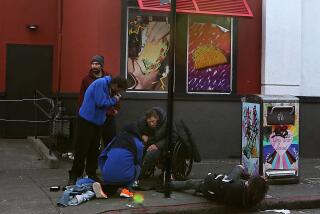Report Cites High-Risk AIDS Behavior in Some Areas
WASHINGTON â Although dramatic changes in sexual behavior have occurred among homosexual men in certain cities with a high incidence of AIDS, high-risk behavior persists in some major cities and in areas with a low rate of the disease, according to a new unpublished report.
The report, a draft of which was obtained by The Times, concluded that high-risk behavior among gay men is least common in San Francisco, the likely result of âcommunity organization and intervention.â
But, in other cities--including New York, which has the highest number of AIDS cases in the nation--âit looks as though there could be quite a bit of high-risk behavior still going on--certainly enough to be concerned,â said Thomas J. Coates, co-director of the Center for AIDS Prevention Studies at UC San Francisco and author of the study.
Dozen Studies Analyzed
The study, funded by the Congressional Office of Technology Assessment and expected to be released in June, examined data on sexual behavior changes in the gay community from about a dozen studies conducted in San Francisco, Los Angeles and New York and in cities with a middle to low prevalence of AIDS.
The report called the changes in such cities as San Francisco âimpressive and important,â but it said that âconsiderable proportions of gay men in these studies, especially from areas not at the epicenter of the epidemic, continue to engage in high-risk behavior.â
Coates said that five years ago 55% of gay men in San Francisco were practicing high-risk behavior, a figure that has since dropped to between 6% and 12%.
âThatâs a fairly dramatic change,â he said in a telephone interview. âBut the data from other cities, including New York, indicate that the changes there havenât been nearly as dramatic.â
Conflicting Studies
For example, the report said one New York study indicated that in 1986 gay men had reduced the number of their male sexual partners and incidents of anal intercourse by more than 70%, but a second New York study the same year reported only an 18% reduction in the percentage of persons who had multiple male sexual partners.
The report said that data from other studies âraise serious concernsâ about continued levels of high-risk behavior. For example, the report said, one study showed that âthe mean number of partners with whom one had engaged in unprotected anal intercourse in Los Angeles in 1986 was 1.6 compared to 1.0 in San Francisco.â
Low Use of Condoms
Other examples cited in the report said that study participants in Mississippi âreported a mean of 19.7 partners with whom they had practiced unprotected anal intercourseâ during the previous year, and that 70% of men at sexually transmitted disease clinics in New Mexico reported practicing anal intercourse during the previous year. Of the New Mexico men, the study said, 87% said their partners used condoms less than 10% of the time.
Coates said that âif you analyze what happened in San Francisco,â the question that then arises is: âCan you recreate that elsewhere?â
âThe critical thing in San Francisco that needs to occur in other cities is the community intervention approach,â he added.
The study described the San Francisco model as one that ârelies heavily on shifting community norms so that low-risk activities are practiced routinely by the community. To do otherwise violates norms.â
Coates said that âwe need to understand better what motivates high-risk behavior, and we probably should mount a community intervention trial in areas where no noticeable changes have taken place.â
Need for Education Cited
Jeffrey Levi, executive director of the National Gay and Lesbian Task Force, agreed.
âThe study proves that there is still a good deal of education to be done in lower incidence communities and it would be dangerous for policy-makers to assume that the job is done in the gay community,â he said.
More to Read
Sign up for Essential California
The most important California stories and recommendations in your inbox every morning.
You may occasionally receive promotional content from the Los Angeles Times.










